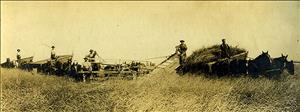On March 21, 1910, the town of Bridgeport in Douglas County incorporates as a city of the fourth class. Settled in the 1860s and originally called Westfield, Bridgeport was renamed in 1892 for a group of investors from Bridgeport, Connecticut, who purchased the town for $60,000 that year. An election to determine incorporation was held on February 23, 1910, and the townspeople voted to incorporate (91 in favor, one opposed). H. F. Klaas is elected mayor and T. J. East treasurer. Five councilmembers are also elected.
Voting for Incorporation
Beginning about 1862, Chinese immigrants arrived to mine for gold in an area along the Columbia River known as Rich Bar, between Bridgeport and Pateros. After the gold ran out, most of the Chinese relocated and new settlers took their place, planting fruit trees and wheat. A small town sprung up called Westfield. Westfield was platted in 1891 by Butler Liversay; the following year the town was purchased for $60,000 by the Western Land and Improvement Association, made up of investors from Bridgeport, Connecticut. The town name was subsequently changed to Bridgeport on July 25, 1892.
In the 1900 census, Bridgeport had 100 inhabitants; Douglas County recorded 4,926 residents. A decade later, the town was home to 500 residents. In an election to decide incorporation, held on February 23, 1910, Bridgeport residents overwhelmingly voted to incorporate (91 to 1). That day, voters also chose H. F. Klaas as mayor, T. J. East as treasurer, and five councilmembers: A. L. Fox, Edward Johnson, S. D. Sanders, B. F. Six, and J. M. Stoddard. The electoral results were validated at a board of commissioners meeting on March 1, 1910, and the incorporation papers were filed with the secretary of state in Olympia on March 21, 1910.
Bridgeport’s First Century
With its strategic position along the Columbia River, in its early days Bridgeport was a hub for supplies and crops coming in from surrounding areas. A steam ferry was installed in 1892 to provide access across the river. By 1910, the town had a bank, flour mill, saw mill, three grocery stores, and a hotel, among other businesses.
In the first few decades of the twentieth century as it transitioned to an agricultural community, Bridgeport’s fortunes began to decline. By 1940, there were only 320 residents and the community could no longer sustain a high school. Teenagers had to be bused some 45 minutes away for classes. But boom times were right around the corner, spurred a decade later by construction that began on the Chief Joseph Dam and the Columbia River Bridge. In 1950, Bridgeport’s population more than doubled, to 802 people.
The concrete gravity dam, built by the U.S. Army Corps of Engineers about a mile east of Bridgeport, was named for Chief Joseph (1840-1904), an important Nez Perce chief who died on the nearby Colville Indian Reservation. Chief Joseph Dam is the second largest hydroelectric dam in the country, after Grand Coulee Dam. Built in 1950, the Columbia River Bridge, also known as the Bridgeport Bridge, was built downstream from the dam. Also built under the direction of the U. S. Army Corps of Engineers, the 1,108-foot-long bridge incorporated a continuous-deck steel truss and a 26-foot wide timber deck, later replaced.
Bridgeport residents enjoy a quiet pace of life, with easy access to fishing and boating on the river or Rufus Woods Lake, formed by the Chief Joseph Dam. In 2009, Bridgeport city officials hired chainsaw sculptor Jacob Lucas to transform 16 dead or dying sycamore trees into a series of sculptures showcasing animals, birds, and local history. Most of the trees line three blocks of Foster Creek Avenue; others are located around town, including a carved mustang outside Bridgeport High School, home of the Mustangs.
Celebrating 100 Years
On June 5, 2010, Bridgeport marked its centennial during the annual Bridgeport Daze, a popular community celebration. Residents turned out for a parade with an honor guard from the Douglas County Sheriff’s Office and 52 parade entrants, including "marching bands from Bridgeport and Brewster, decorated bicycles, classic cars, hot rods, pro hoppers, the sheriff’s emergency operations center, the World War II halftrack from Berryman Park, floats from local businesses, the Bridgeport Youth Soccer teams, fire trucks, ambulance and emergency services vehicles, political candidates, motorcycles and horses dancing to a Latin beat" ("Bridgeport Celebrates Centennial in Style"). About 20 vendors provided food and crafts to attendees. There was also live music and a special guest appearance by 89-year-old Joe Kropp, who graduated from Bridgeport High School in 1939. At the event, Bridgeport Mayor Steve Jenkins dedicated the latest in the city’s collection of carved trees, Sleeping Fisherman, also carved by Jacob Lucas. The new sculpture is located in Marina Park.

